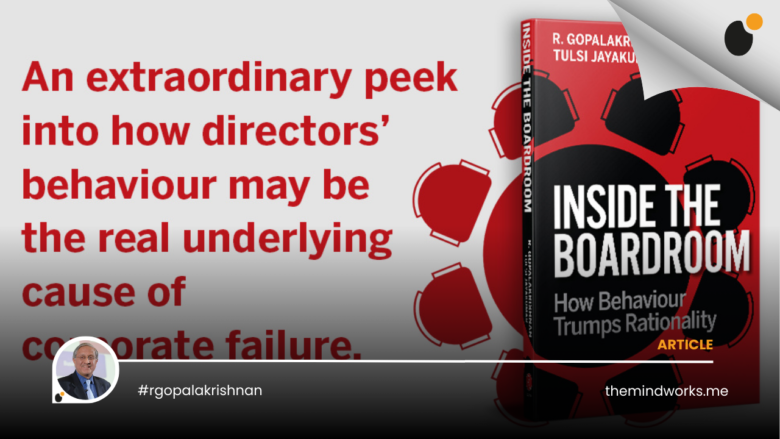BS The Wise Leader (51)
To appear on 12-4-22
When the Spiritual and the Material combine
By R. Gopalakrishnan*
(The writer is an author and a business commentator. His articles and videos can be accessed at his website www.themindworks.me and his email ID is rgopal@themindworks.me)
Practitioners of corporate governance are often challenged when the spiritual and material combine. One is faith-based, and the other is wealth-based. Spiritual and material tend to conflict because everyone loves God, money, politics, and sex! No wonder that Godmen have several books written about them—Khushwant Singh (2003), Bhavdeep Kang (2016) and Priyanka Pathak Narain (2017).
Ruchi Soya Industries Ltd (RSIL) recently raised equity. When RSIL started in the 1980s, I had just completed a feasibility study on soya. Subsequently, RSIL became insolvent. In 2017, it was acquired by associates of yoga guru, Baba Ramdev. In India, yoga and business have profoundly mysterious links. Godmen combine the spiritual and material, so they are able to act as power brokers. Recall Shraddha Mata, Chandraswami, and many others while our newly independent nation grew into today’s India@75.
Dhirendra Brahmachari, a hatha yoga expert, was powerful during Ms. Indira Gandhi’s tenure as PM. He built a dubious empire. So did Maharshi Mahesh Yogi and Osho Rajnish. Abhay De, better identified as Swami Prabhupada, arrived in New York in 1965 with nothing. By 1976, he owned the ISKON chain of marble and gold temples in 12 countries with assets over USD 1 billion. There exists a secret admiration for godmen’s Rasputin-like hold over important personalities. Currently, a new IPO, which links yoga with business, has been reported.
Baba Ramdev is described as a yoga guru–which he most certainly is. He is also projected as an entrepreneur–which is less obvious. His unlisted firm, Patanjali Ayurved, acquired influential television channels and is in the ayurvedic and consumer product business. The company makes bombastic claims, which upon challenge, often get retracted, but not without some high-profile publicity. Patanjali products are endorsed by VIPs like the Health Minister’s support for Coronil for COVID. Patanjali’s recent public offer had some controversies about unfair promotional tactics.
In 2015, Patanjali Ayurved was reported to be accelerating so rapidly that by 2020, its projected turnover would exceed sales of established FMCG companies, and by 2025, its revenue would be Rs. 120,000 crores! Professional equity analysts wrote effusive stories. Today these numbers appear implausible. But then who can predict the magic that may yet happen?
In 2019, unlisted Patanjali acquired visibility in the stock market when it beat an influential Adani Wilmar in a race to buy the debt-laden RSIL. Even though Adani Wilmar had bid higher at Rs 5,474 crores, Patanjali successfully raised legal objections. Mysteriously, Adani Wilmar withdrew its bid. Patanjali’s lower Rs 4,350 crores bid became the winner but with a curious twist—funding of the acquisition would be by Patanjali taking loans from the very same public sector banks that had just taken a 52% haircut on their NPA loans to RSIL. Sheer magic!
Some players have manipulated the IBC code within the regulations, so that the process and outcome leave a lot to be desired. State-owned banks have cooperated through an “accommodation transaction” according to an ex-banker. Why would public sector banks massively write down loans to a company, and then have the temerity to give fresh loans to a buyer for the purchase of the same company? Well, it seems in October 2019, the finance minister made an astounding announcement: that banks should not hesitate to extend loans to self-help groups and companies backed by spiritual leaders. Puzzling statement from any nation’s FM.
Godmen, like Russian oligarchs, have a cathartic effect on sound lending principles and sustainable enterprise building. Many, though not all, acquire disproportionate wealth through dubious means right under the nose of authorities. They appear to be shady, but nobody can quite fix their shadiness. Like oligarchs, they are perceived to enjoy such high political patronage that the system just falls in line. When the bubble bursts, the ‘I told you so’ commentators will climb out of the woodwork.
The Ukraine crisis highlights the classic example of oligarch Abramovich who became a billionaire from being a poor orphan. Abramovich made his first killing from dealings in the automotive sector. He then befriended and partnered Berezovsky, a well-connected and established oligarch. Using Berezovsky’s powerful contact with Boris Yeltsin, the duo proposed that the Russian government first merge a public sector crude oil producer with a public sector refinery–and then, hand over the enlarged business to their partnership. In return, the oligarchs offered to fund and promote a pro-Yeltsin television station. In 1995, the 29-year-old Abramovich invested USD 19 million in equity plus USD 220 million loans, to acquire 90% of the merged giant. Intriguingly, he managed to sell the company back to the public sector Gazprom for a profit of US $10 billion! Similar tactics helped Abramovich to acquire interests in aluminum and steel.
Abramovich and Patanjali share some features. Both are led by leaders of similar age, both are close to ruling leaders, both run influential television stations, both buy major shareholding in listed assets at depressed values and flog the same assets for a huge profit. Both attract admiration from some, but also deep suspicion from many. When business logic is stripped of political associations, something crumbles.
As Alice in Wonderland exclaimed – ‘It gets curiouser and curiouser.’ Before we have our own Zuccotti Park-like Occupy Wall Street, lenders, investors, and regulators must avert the risks of a heady mix of business and spirituality.



